A 1 to 7 rating scale survey enables businesses to collect feedback from their target audiences by asking them to give a rating between 1 and 7 based on their opinion of the same.
They offer a practical solution that delivers both precision and granularity. It enables businesses to differentiate opinions and satisfaction levels while keeping the process straightforward for respondents.
So, how can you make the most of this versatile survey tool? Let’s explore its benefits, design considerations, and applications across various industries.
TL;DR
- 1 to 7 rating scale surveys are effective for collecting precise and detailed feedback. They allow businesses to differentiate opinions and satisfaction levels through quantitative feedback while keeping the process straightforward for respondents.
- Compared to 1 to 5 rating scale surveys or 1 to 10 opinion scale surveys, these surveys have the ideal number of scale points, providing a balance between enough points to capture distinguished responses and not overwhelming them with too many points.
- They can be used effectively across various industries for customer satisfaction, employee engagement, and product evaluation.
- You can easily use various scales and question styles to capture your 7 scale points survey. These can be star rating scale, heart rating, smiley face scale, circle rating, Likert scale survey, buttons, pictures, and more.
- Designing clear, simple, and balanced questions with consistent scale points across all questions is crucial for effective feedback collection.
- They are commonly used to gauge feedback across industries like healthcare, retail, education, corporate, hotels, digital products, and more.
- You can use these surveys on websites, mobile apps/SMS, in-product, email, or offline surveys. Utilizing this tool will provide actionable insights that can lead to product improvement and overall business growth.
- With Zonka Feedback, you can choose from a variety of 1 to 7-rating surveys, measure feedback through different channels, and understand customer sentiment better. Schedule a demo with Zonka Feedback to understand the products and create your own 1 to 5 rating scale survey.
Understanding 1 to 7 Rating Surveys
A 1 to 7 rating scale is a method of assessing the intensity or magnitude of something, such as customer satisfaction, employee engagement, or product quality. These scales are straightforward and simple to use, offering a range of advantages, such as increased accuracy and detail in responses.
Participants are asked to rate a particular item or statement on a scale ranging from 1 to 7, where each number represents a different level of agreement or satisfaction. Here's a typical breakdown of this survey scale:
- Strongly Disagree
- Disagree
- Slightly Disagree
- Neither Agree nor Disagree
- Slightly Agree
- Agree
- Strongly Agree
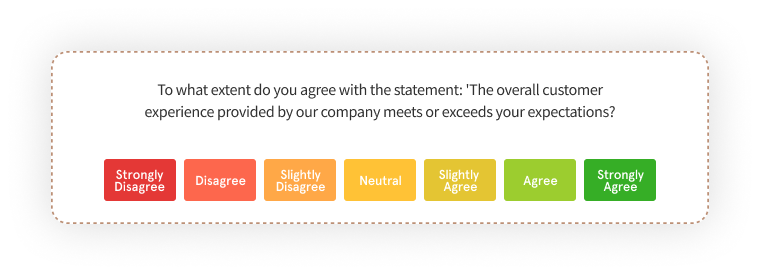
Apart from the agreement scale, it can have a numeric scale, satisfaction scale, frequency scale, likelihood scale, and many more types of scales to capture customer sentiment. You can also use a variety of survey question types to assess the feedback more precisely.
However, there are also some limitations to consider, like the potential for confusion or indecision among respondents when faced with a seven-point rating scale question.
Understanding the different types of scales available is key to making the most of a 1 to 7 rating scale survey. Depending on the industry and subject matter, you may choose from linear numeric scales, paired comparison scales, or even Likert scale questionnaires.
Choosing the right scale type allows for accurate mapping of the underlying construct and differentiation among respondents, leading to more insightful and actionable data.
1 to 7 Rating Survey Types
There are various types of rating scales that can be used in surveys and adaptive assessments to gather valuable data and insights. These rating scales provide a structured way to measure satisfaction level, gauge attitudes and opinions, and collect quantitative data. In the original blog post, some examples of rating scales were mentioned, such as satisfaction scales, Likert scales, slider scales, and star scales.
1. 1 to 7 Satisfaction Scales
This 7-point rating scale measures customer satisfaction levels. These scales allow respondents to rate their satisfaction with a product or service on a scale, typically ranging from 1 to 7, where 1 represents the lowest level of satisfaction and 7 represents the highest level.
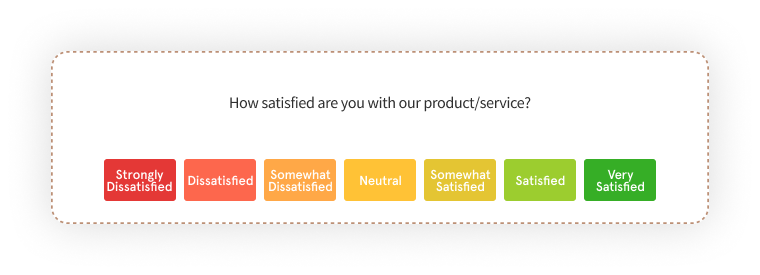
2. 1 to 7 Likert Rating Scales
These Likert scale questions are used to gauge respondents' attitudes or opinions toward a subject. These scales consist of a series of statements or questions to which respondents indicate their level of agreement or disagreement on a 1 to 7 scale, where 1 represents "strongly disagree" and 7 represents "strongly agree".
You can use a Likert scale survey template that can help you capture customer sentiment comprehensively and make informed decisions regarding their satisfaction levels.
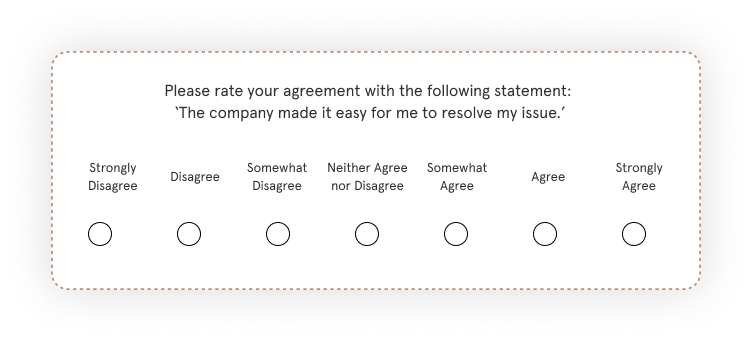
3. 1 to 7 Slider Scales
These provide respondents with the flexibility to select any point between two points of measurement. This type of scale allows for a more nuanced response and can be used to gather detailed feedback or opinions.
4. 1 to 7 Star Scales
These types of survey scales typically range from 1 to 7 stars. They are commonly used in online reviews or app ratings. Users can assign a star rating to indicate their satisfaction or experience, with 1 star representing the lowest rating and 7 stars representing the highest.
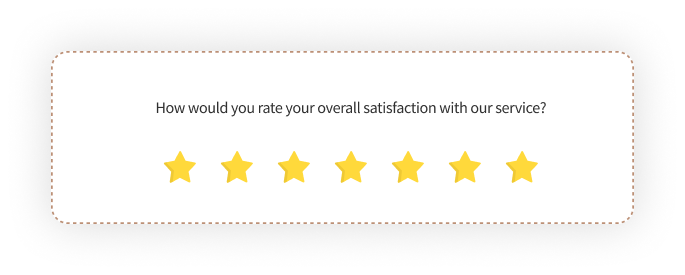
5. 1 to 7 Agreement Scale
The 1 to 7 Agreement Scale is a type of scale that measures the level of agreement or disagreement of respondents towards a statement or question. It allows individuals to express their opinions or attitudes on a spectrum ranging from 1 (strongly disagree) to 7 (strongly agree).
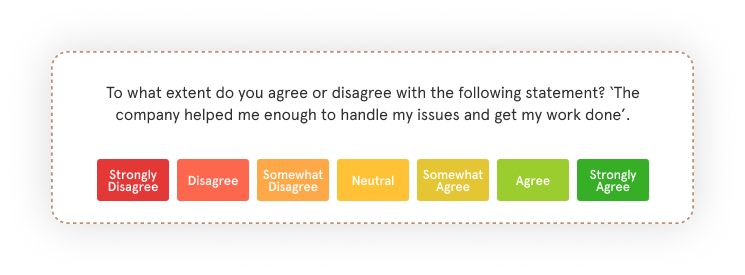
6. 1 to 7 Frequency Scale
The 1 to 7 Frequency Scale is another type of rating scale that is commonly used in surveys to measure the frequency or occurrence of a particular behavior or event. It allows respondents to indicate how often they engage in a specific activity or experience a certain event on a scale ranging from 1 (never) to 7 (very frequently).
This scale is particularly useful in gathering data on habits, routines, or patterns of behavior. Providing respondents with a range of options allows for a more nuanced understanding of the frequency of the behavior being measured.
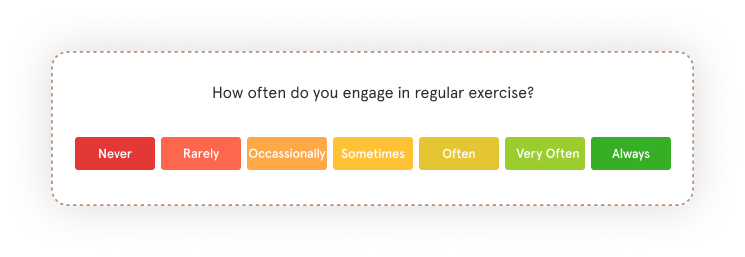
7. 1 to 7 Numercial Scale
The 1 to 7 Numerical Scale is another type of rating scale commonly used in surveys to measure various attributes or characteristics. This scale allows respondents to rate a particular item, concept, or experience on a scale ranging from 1 (low) to 7 (high).
The 1 to 7 Numerical Scale is particularly valuable when gathering data on subjective opinions or preferences. It provides a structured framework for respondents to express their level of agreement, satisfaction, or preference with a specific item or concept.
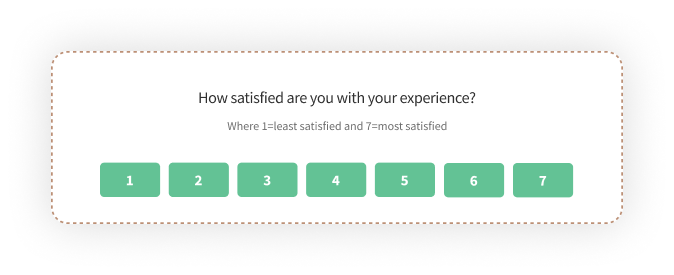
8. 1 to 7 Importance Scale
The 1 to 7 Importance Scale is a type of rating scale that allows respondents to indicate the level of importance they assign to a particular item, concept, or attribute. It provides a structured framework for respondents to express their preferences or priorities on a scale ranging from 1 (low importance) to 7 (high importance).
This scale is particularly useful in gathering data on subjective opinions and preferences. It enables researchers to understand the relative importance of different factors and helps in making informed decisions based on the feedback received.
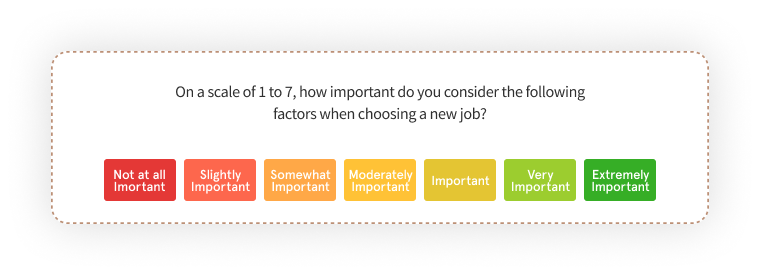
1 to 7 Rating Questions and Examples Based on Use Cases and Industry Applications
1 to 7 rating scale surveys have various applications across industries, including measuring customer satisfaction, employee engagement, and product evaluation.
In this section, we’ll explore these use cases and discuss how a 1 to 7 rating scale can provide valuable insights for businesses in different sectors.
1. To Measure Customer Satisfaction
Employing a 1 to 7 rating survey to measure satisfaction and loyalty provides businesses with insights that assist in improving their products and services.
For example:
- "How satisfied are you with our product/service?" (1 = Very Dissatisfied, 7 = Very Satisfied)
- "To what extent did our product/service meet your expectations?" (1 = Did Not Meet Expectations, 7 = Exceeded Expectations)
- "How satisfied are you with the ease of use of our product/service?" (1 = Very Dissatisfied, 7 = Very Satisfied)
- "How satisfied are you with the overall experience of interacting with our company?" (1 = Very Dissatisfied, 7 = Very Satisfied)
Customer satisfaction surveys can assess satisfaction with product quality, ease of use, and overall experience, while customer loyalty surveys can help businesses understand the likelihood of customers recommending their products or services.
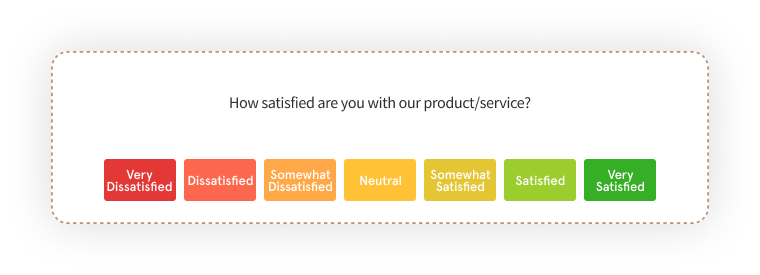
2. To Collect Customer Service Feedback & Measure Agent Performance
Gauging satisfaction with support and service experiences is another crucial aspect of 1 to 7 rating scale surveys. You can use a customer service survey to ask respondents to rate their satisfaction with the support they received, such as the timeliness of the response, the helpfulness of the support staff, and the overall resolution of their issue on a 7-point rating scale.
For example:
- "How satisfied are you with the assistance provided by our customer service agent?"(1 = Very Dissatisfied, 7 = Very Satisfied)
- "To what extent did the agent address your issue or question effectively?" (1 = Not Effective at All, 7 = Extremely Effective)
- "How satisfied are you with the response time of our customer service team?" (1 = Very Dissatisfied, 7 = Very Satisfied)
- "How well did the agent communicate and explain the resolution or information?" (1 = Poor Communication, 7 = Excellent Communication)
- "On a scale from 1 to 7, how knowledgeable was the customer service agent?" (1 = Not Knowledgeable at All, 7 = Very Knowledgeable)
This type of question helps businesses identify areas for improvement in their support and service offerings, ultimately leading to higher satisfaction levels and loyalty.
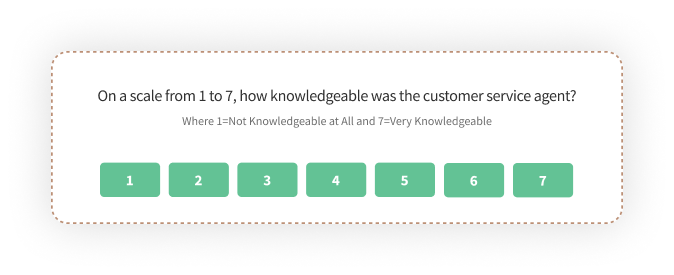
3. To Assess Website Usability
To assess website usability, a 1 to 7 rating scale question can be used to gather valuable feedback. This question allows respondents to rate the overall ease of use of the website on a scale ranging from 1 (Very Difficult) to 7 (Very Easy). By asking this question, businesses can gain insights into how user-friendly their website is and identify areas for improvement.
- "How would you rate the overall ease of use of our website?" (1 = Very Difficult, 7 = Very Easy)
- "To what extent were you able to find the information you were looking for on our website?" (1 = Not at All, 7 = Extremely)
- "How satisfied are you with the navigation options available on our website?" (1 = Very Dissatisfied, 7 = Very Satisfied)
You can also check out this blog on website usability survey questions to get a list of other questions that you can modify to integrate into your 1 to 7 rating scale surveys.
4. To Collect Feedback about Product Quality and Usability
To assess product quality and usability, you can ask respondents to rate their satisfaction with aspects like product quality, ease of use, and overall satisfaction on a 1 to 7 scale.
Some of the top product survey questions are:
- “On a scale of 1 to 7, how satisfied are you with the quality of our product?”
- “On a scale of 1 to 7, how easy was it for you to use our product?”
- "How innovative do you find our latest product?" (1 = Not Innovative, 7 = Highly Innovative)
- "How likely are you to recommend our new feature to others?" (1 = Very Unlikely, 7 = Very Likely)
Such questions on product feedback pave the way for valuable insights into your product’s strengths and weaknesses, thereby aiding in improvements and boosting customer satisfaction.
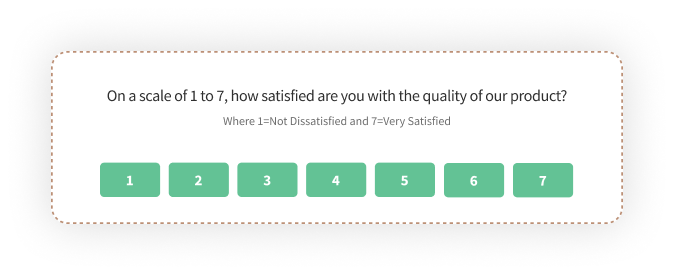
5. Employee Feedback and Development
Collecting employee feedback on workplace satisfaction, development opportunities, and management is essential for businesses to identify areas of improvement and growth. By using employee feedback software to send a 1 to 7 rating scale, companies can capture data on employee satisfaction with aspects like job satisfaction, opportunities for growth, and management support.
For example:
- “On a scale of 1 to 7, how satisfied are you with the development opportunities available at our company?”
- "On a scale from 1 to 7, how clear are your career advancement opportunities within the company?" (1 = Not Clear at All, 7 = Very Clear)
- "How well do your current responsibilities align with your career goals?" (1 = Not Aligned at All, 7 = Perfectly Aligned)
- "To what extent do you feel your skills are utilized in your current role?" (1 = Not Utilized at All, 7 = Fully Utilized)
By asking these types of questions, businesses can gain valuable insights into employee satisfaction and identify areas where improvements can be made to enhance employee engagement and performance.
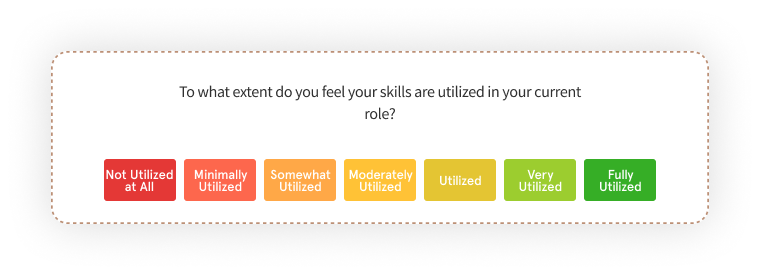
6. Healthcare or Patient Feedback
Capturing patient feedback can be effectively done using a 1 to 7 rating survey. It can help you capture feedback regarding a variety of aspects of the patient experience like communication, hygiene, patient involvement, appointment experience, doctor's knowledge, privacy and comfort, facility's cleanliness, and more.
Here are some of the top health assessment questions as well as patient satisfaction survey questions that you can ask:
- How would you rate your overall experience with our healthcare services?" (1 = Very Dissatisfied, 7 = Very Satisfied)
- "On a scale of 1 to 7, how satisfied were you with the timeliness of your appointments and waiting times?" (1 = Very Long Wait, 7 = Very Short Wait)
- "On a scale from 1 to 7, how courteous and professional was the staff at the healthcare facility?" (1 = Very Rude and Unprofessional, 7 = Very Courteous and Professional)
- "To what extent would you rate the cleanliness and hygiene of our healthcare facility?" (1 = Very Poor, 7 = Excellent)
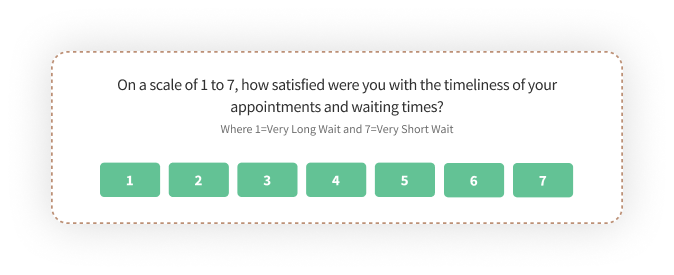
Best Survey Channels for Collecting 1 to 7 Feedback
Collecting 1 to 7 feedback can be done through various channels, including website surveys, mobile apps, email surveys, in-product surveys, and offline surveys.
In this section, we’ll discuss the most effective channels for collecting 1 to 7 feedback, helping you choose the best method for your specific needs and objectives.
1. Website Surveys
Website surveys are an excellent channel for collecting 1 to 7 feedback from visitors and customers. By embedding a survey directly on your website, you can capture user feedback in real time, providing valuable insights for improvement.
Website surveys are a convenient and cost-effective method for feedback collection, as they can be easily set up and maintained with minimal resources. Integrating a 1 to 7 rating scale to collect website feedback offers a broader understanding of user opinions and emotions, thereby facilitating data-driven decisions for your business.
2. Mobile Apps and SMS
Mobile apps and SMS are another effective channel for collecting 1 to 7 feedback, allowing you to reach respondents on-the-go and collect real-time feedback. With the majority of consumers using smartphones, mobile app surveys and SMS surveys provide a convenient way for users to share their opinions and experiences.
Incorporating a 1 to 7 rating scale in your mobile app or SMS surveys allows for valuable insights into customer satisfaction, loyalty, and overall experience, thereby facilitating informed decisions to improve your products and services. You can easily use SMS survey software or online survey tools to send surveys, feedback forms, and polls or quizzes as mobile notifications or text messages.
3. Email Surveys
Email surveys are among the most popular ways to collect customer feedback and offer a familiar and convenient channel for collecting 1 to 7 feedback from customers and employees. By sending out surveys via email, you can reach a large number of respondents quickly and efficiently.
Additionally, using a 1 to 7 rating scale in your email surveys ensures that respondents can easily understand and respond to the questions, providing you with accurate and meaningful feedback.
By analyzing the data collected through email surveys, you can make data-driven decisions to improve your products, services, and overall customer experience.
4. In-Product and In-app Surveys
In-product and in-app surveys provide a unique opportunity to collect user feedback directly within your product or app, giving you valuable insights into user experience and satisfaction. By embedding a 1 to 7 rating scale survey into your product or app, you can capture real-time feedback from users as they interact with your product.
This direct feedback can help you identify areas for improvement and make necessary changes to enhance the overall user experience. In-product and in-app surveys can be a powerful tool for collecting 1 to 7 feedback and driving product development.
5. Offline Surveys
Offline surveys, such as paper surveys or in-person interviews, can be an effective method for collecting 1 to 7 feedback in situations where online access is limited or unavailable. Although they may require more resources and effort compared to online surveys, using the best survey apps for offline data collection can provide a comprehensive data collection approach that ensures you capture feedback from a diverse range of respondents.
Including a 1 to 7 rating scale in your offline surveys enables the collection of precise and actionable feedback, which can be utilized to enhance your products, services, and the overall customer experience.
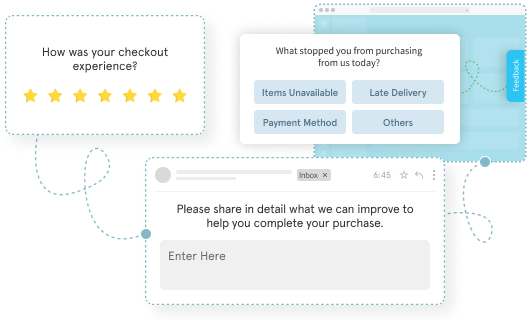
Advantages of using a 1 to 7 Rating Scale
Using a 1 to 7 linear numeric scale offers several benefits:
-
It provides increased accuracy and detail in responses, allowing for clearer distinctions between opinions and satisfaction levels.
- It offers greater precision and granularity compared to other rating scales by providing more scale points for detailed responses.
-
It enhances the collection of quantitative data.
-
When using a bipolar construct, a 1 to 7 point scale, where 1 represents “strongly disagree” and 7 represents “strongly agree”, is recommended.
-
This scale is suitable for Likert scale survey questions, offering insights across language boundaries.
-
It supplies approximate responses without delving further into specifics.
Some Limitations and Considerations of 1 to 7 Rating Surveys
While 1 to 7 rating scales offer more options for respondents, they also come with some drawbacks. For example, it may not provide detailed information about experiences or motivations behind behavior.
Additionally, respondents may become disinterested or fatigued due to the excessive amount of response options, leading to lower response rates or even survey abandonment.
In summary, a 1 to 7 rating scale provides a wider range of options but could potentially lead to confusion or difficulty in making decisions among respondents and may require more effort to process the data.
Tips for Designing Effective 1 to 7 Rating Scale Questionnaires
The success of your 1 to 7 rating survey hinges on designing clear, simple, and consistent survey questions that maintain a balance between positive and negative options.
In this section, we’ll provide tips for creating effective 1 to 7 rating scale questions, covering aspects such as clarity and simplicity, consistency in scale points, and balancing positives and negatives.
1. Clarity and Simplicity
One of the keys to designing effective 1 to 7 rating scale questions is ensuring that questions and response options are easy to understand and straightforward for respondents.
Clear and precise labels in rating questions help prevent ambiguity and confusion, guaranteeing that respondents can easily comprehend the meaning of each scale point. Incorporating a semantic differential scale can further enhance the clarity and precision of these questions.
A focus on clarity and simplicity aids in crafting 1 to 7 rating scale questions that yield reliable and valid data.
2. Consistency in Scale Points
Maintaining a consistent scale across all questions is essential to prevent misunderstandings and guarantee precise data accumulation. Utilizing the same scale points for each question facilitates easier analysis and interpretation of the data, enhancing the reliability and validity of the survey results.
Ensuring consistency in scale points aids in crafting 1 to 7 rating scale questions that yield accurate and comparable feedback using a comparative scale, such as the paired comparison scale.
3. Balancing Positives and Negatives
It’s important to provide an equal number of positive and negative response options in a 1 to 7 Likert scale question to encourage impartial feedback.
By including both positive and negative statements, you can capture a range of opinions and feedback, ensuring that respondents are able to express their true feelings and provide a more precise assessment.
Keeping a balance between positives and negatives in your 1 to 7 rating scale questions helps in avoiding bias and gaining a broader understanding of the subject.
4. Tailoring Questions to Specific Contexts
When designing survey questions, it is crucial to customize them to align with the specific context of your survey. This means tailoring the questions to be relevant and meaningful to the respondents, taking into account the unique factors and considerations of the healthcare services being evaluated.
By addressing context-specific factors, you can enhance the validity of the responses received. For example, if you are collecting feedback on the timeliness of appointments and waiting times, it is important to frame the questions in a way that reflects the specific scheduling processes and protocols of your healthcare facility.
Contextual surveys increase the likelihood of receiving accurate and valuable feedback, as respondents can provide insights that are directly applicable to their experiences within the healthcare setting.
Conclusion
In conclusion, the 1 to 7 rating scale survey is a versatile tool that can provide valuable insights across various industries and applications. By designing clear, simple, and consistent questions, you can create effective rating scale surveys that help you better understand customer satisfaction, employee engagement, and product quality.
By choosing the right survey channel, such as website surveys, mobile apps, email surveys, or in-product surveys, you can reach a diverse audience and collect comprehensive feedback that drives informed decision-making.
As you implement 1 to 7 rating scale surveys in your business, remember to consider the advantages, limitations, and best practices mentioned in this blog post.
By carefully crafting your questions and selecting the most appropriate survey channel, you can gather meaningful feedback that helps you improve your products, services, and overall customer experience. Embrace the power of the 1 to 7 rating scale and let it guide you toward greater success in your business endeavors.
You can use Zonka Feedback to create and send your 1 to 7 rating surveys. This survey software allows you to create surveys using ready-to-use templates as well as create a survey from scratch.
You can schedule a demo to understand how you can use the tool to collect customer feedback effectively.

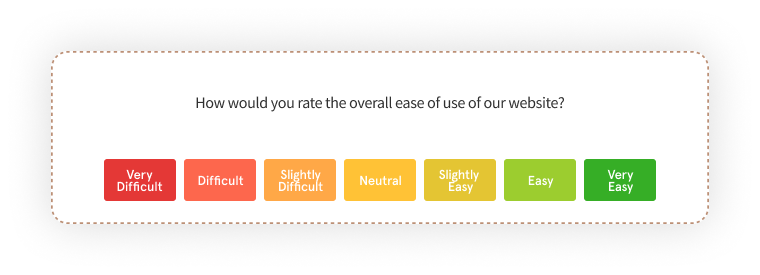

.png)
.jpg)



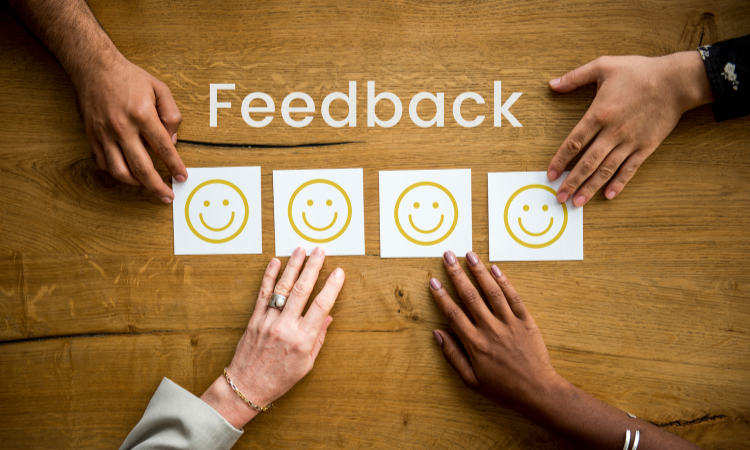


.jpg)